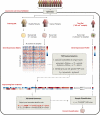Relative expression analysis for molecular cancer diagnosis and prognosis
- PMID: 20218737
- PMCID: PMC2921829
- DOI: 10.1177/153303461000900204
Relative expression analysis for molecular cancer diagnosis and prognosis
Abstract
The enormous amount of biomolecule measurement data generated from high-throughput technologies has brought an increased need for computational tools in biological analyses. Such tools can enhance our understanding of human health and genetic diseases, such as cancer, by accurately classifying phenotypes, detecting the presence of disease, discriminating among cancer sub-types, predicting clinical outcomes, and characterizing disease progression. In the case of gene expression microarray data, standard statistical learning methods have been used to identify classifiers that can accurately distinguish disease phenotypes. However, these mathematical prediction rules are often highly complex, and they lack the convenience and simplicity desired for extracting underlying biological meaning or transitioning into the clinic. In this review, we survey a powerful collection of computational methods for analyzing transcriptomic microarray data that address these limitations. Relative Expression Analysis (RXA) is based only on the relative orderings among the expressions of a small number of genes. Specifically, we provide a description of the first and simplest example of RXA, the K-TSP classifier, which is based on _ pairs of genes; the case K = 1 is the TSP classifier. Given their simplicity and ease of biological interpretation, as well as their invariance to data normalization and parameter-fitting, these classifiers have been widely applied in aiding molecular diagnostics in a broad range of human cancers. We review several studies which demonstrate accurate classification of disease phenotypes (e.g., cancer vs. normal), cancer subclasses (e.g., AML vs. ALL, GIST vs. LMS), disease outcomes (e.g., metastasis, survival), and diverse human pathologies assayed through blood-borne leukocytes. The studies presented demonstrate that RXA-specifically the TSP and K-TSP classifiers-is a promising new class of computational methods for analyzing high-throughput data, and has the potential to significantly contribute to molecular cancer diagnosis and prognosis.
Figures
Similar articles
-
Simple decision rules for classifying human cancers from gene expression profiles.Bioinformatics. 2005 Oct 15;21(20):3896-904. doi: 10.1093/bioinformatics/bti631. Epub 2005 Aug 16. Bioinformatics. 2005. PMID: 16105897 Free PMC article.
-
Instance-based concept learning from multiclass DNA microarray data.BMC Bioinformatics. 2006 Feb 16;7:73. doi: 10.1186/1471-2105-7-73. BMC Bioinformatics. 2006. PMID: 16483361 Free PMC article.
-
Kernel-imbedded Gaussian processes for disease classification using microarray gene expression data.BMC Bioinformatics. 2007 Feb 28;8:67. doi: 10.1186/1471-2105-8-67. BMC Bioinformatics. 2007. PMID: 17328811 Free PMC article.
-
Classification algorithms for phenotype prediction in genomics and proteomics.Front Biosci. 2008 Jan 1;13:691-708. doi: 10.2741/2712. Front Biosci. 2008. PMID: 17981580 Free PMC article. Review.
-
Microarrays for cancer diagnosis and classification.Adv Exp Med Biol. 2007;593:74-85. doi: 10.1007/978-0-387-39978-2_8. Adv Exp Med Biol. 2007. PMID: 17265718 Review.
Cited by
-
Quantitative or qualitative transcriptional diagnostic signatures? A case study for colorectal cancer.BMC Genomics. 2018 Jan 29;19(1):99. doi: 10.1186/s12864-018-4446-y. BMC Genomics. 2018. PMID: 29378509 Free PMC article.
-
Development and Validation of an Individualized Immune Prognostic Signature in Early-Stage Nonsquamous Non-Small Cell Lung Cancer.JAMA Oncol. 2017 Nov 1;3(11):1529-1537. doi: 10.1001/jamaoncol.2017.1609. JAMA Oncol. 2017. PMID: 28687838 Free PMC article.
-
Big data and computational biology strategy for personalized prognosis.Oncotarget. 2016 Jun 28;7(26):40200-40220. doi: 10.18632/oncotarget.9571. Oncotarget. 2016. PMID: 27229533 Free PMC article.
-
Identification and Verification of a 17 Immune-Related Gene Pair Prognostic Signature for Colon Cancer.Biomed Res Int. 2021 May 22;2021:6057948. doi: 10.1155/2021/6057948. eCollection 2021. Biomed Res Int. 2021. PMID: 34124251 Free PMC article.
-
The Prediction of Survival in Hepatocellular Carcinoma Based on A Four Long Non-coding RNAs Expression Signature.J Cancer. 2020 Apr 12;11(14):4132-4144. doi: 10.7150/jca.40621. eCollection 2020. J Cancer. 2020. PMID: 32368296 Free PMC article.
References
-
- Bicciato S, Pandin M, Didonè G, Di Bello C. Pattern identification and classification in gene expression data using an autoassociative neural network model. Biotechnol. Bioeng. 2003;81:594–606. - PubMed
-
- Boulesteix AL, Tutz G, Strimmer K. A CART-based approach to discover emerging patterns in microarray data. Bioinformatics. 2003;19:2465–2472. - PubMed
-
- Dettling M, Buhlmann P. Boosting for tumor classification with gene expression data. Bioinformatics. 2003;19:1061–1069. - PubMed
Publication types
MeSH terms
Grants and funding
LinkOut - more resources
Full Text Sources
Miscellaneous


